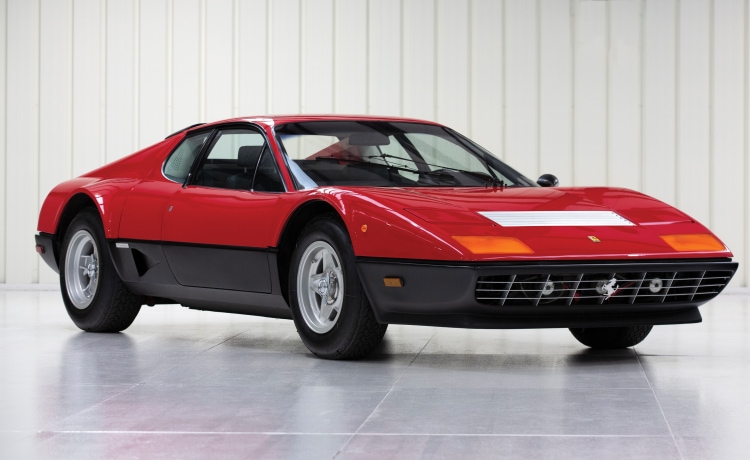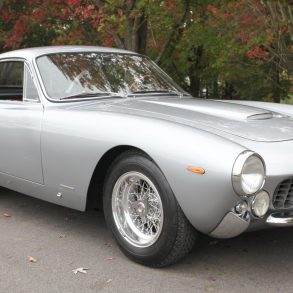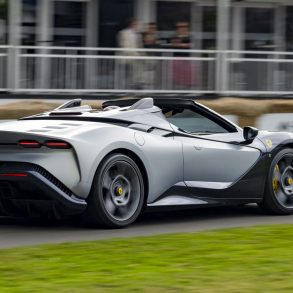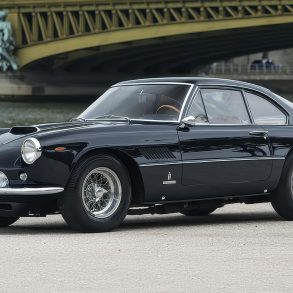A review of the Ferrari 365 GT4 BB and Ferrari 512 BB
Many of us know it as the Berlinetta Boxer, while some preferred Brigitte Bardot, but the truth of the matter is it was actually Berlinetta Bialbero. Whatever you want to name it, there’s no doubt that the Ferrari BB series was a major pivotal point for Enzo Ferrari and his thoroughbred mechanical horses.
When the Ferrari 365 GT4 BB was introduced back at the Turin Motor Show in 1971, it was quite literally a Ferrari like no other. With a flat-12 engine behind the driver and a slot for license plates, the Berlinetta Boxer introduced a new breed of road-going Ferraris, a breed The Old Man never thought he’d build.

The Berlinetta Boxer series marked Ferrari’s readjustment to the new and ever-changing world of high-performance cars and being built in minimal numbers, it is unsurprisingly a sought after collector car.
So, who and what inspired this sleek silhouette? Why is the engine not V-shaped and what does Berlinetta Bialbero mean? Finally, where’s the BB’s place in history? We’re here to put a spotlight on this cult classic by addressing all these questions and more!
Background
Up to the late 1960s, there was really one shape for a high end sports car and it was a grand touring coupé. With its V12 engines, alluring artisan-made bodies and limited supply, Ferrari was a supreme ruler in this prestigious club and cars from the 250, 275 and 365 series are today considered to be Ferrari’s pinnacle.

From the mid-fifties and all through the mid-sixties, the venerable Ferrari 250 series was the best sports car money could buy. Proven both on the race tracks and the country clubs, these opulent grand tourers attracted the most discerning customers around Europe and the US, including Alain Delon, Steve McQueen, and Sir Stirling Moss, just to name a few.

The 275 Series was a worthy successor to the 250 and was yet again endorsed by A-list celebrities and both factory and private racing teams. The introduction of the four-cam variant, the 275 GTB/4, was also a step forward for Ferrari, further cementing Enzo’s reigning status.
Finally, for American buyers who found the European Colombo V12 engines too small, Ferrari offered the America series where the displacement went as big as 5.0 liters in the 330 Superamerica.
Needless to say, Ferrari was a dominant upscale carmaker, with the closest challenger being Maserati. Still, the trident-wearing grand tourers didn’t enjoy such a powerful market presence in North America, where Ferrari thrived. And even though the DB and the E-Type/XK-E were amazing cars, Aston Martin or Jaguar was six cylinders short of making grand tourers to really match Ferrari’s V12 grand tourers.
The status quo changed when Ferrucio Lamborghini entered the game. The wealthy industrialist and tractor manufacturer famously gathered a team of first-class engineers and designers, building the 350 GT.

Development
Enzo didn’t consider Ferrucio Lamborghini as a real threat until the 1965 Turin Motor Show, where the spiteful tractor manufacturer infuriated Mr. Ferrari with nothing but the naked rolling chassis of the Miura.

The revolutionary construction and a transversely-mid-mounted V12 were what caused Enzo Ferrari to storm off from the fair and that’s what ultimately pushed Ferrucio even further in his goal to produce an ultimate supercar.
Now, the mid-engined layout wasn’t all that groundbreaking, at least not in the racing world. Up to that point, both open-wheel and closed-wheel competition cars adopted the layout which provided better weight distribution.
Enzo reluctantly embraced this construction for his race track machinery with the 1960 246 P Formula 1 car. There was the 250 LM as well, yet it was a homologation special built from 1963 to 1965 rather than an actual road car as Ferrari was adamant to keep the mid-engined layout away from road cars and for track purposes only.
However, when the Lamborghini Miura finally appeared clad in Gandini’s body in 1966, it became apparent that Ferrari just had to respond accordingly to keep its grip on the market.

In the same year, Ferrari introduced the 365P, a three-seater Ferrari concept car with a central seating position. Aldo Brovarone’s masterful design was finalized in just two examples and they went to Chinotti and Agnelli families.
A scaled-down variant of this car appeared in 1967 as the mid-engined V6-powered Dino, but Enzo Ferrari still was still far from unveiling a mid-engined car bearing the Cavallino Rampante badge.
Behind the factory walls, Ferrari and Pininfarina started experimenting on mid-engined designs, showcasing the Pininfarina P6 at the 1968 Turin Auto Show. Leonardo Fioravanti’s wedge-shaped silhouette previewed Ferrari’s new design direction, but the technical aspect was far from being ready.

The P6 show car was meant to feature a 3.0-liter 60° Colombo V12, but Ferrari deemed adapting the engine to the new layout too impractical.
As a solution, the engineering team turned to Giuliano de Angelis’ and Angelo Bellei’s flat-12 from the 312B and 312 PB race cars.
In a mid-engined layout, a 180° unit proved more practical than a longitudinally-mounted V12, enabling the car to have a shorter wheelbase due to the engine’s radically lower height.
However, the decision to place the gearbox unit under the crankshaft raised the center of gravity and annulled one potential upside of a flat engine.
Before Ferrari fully developed its first mid-engined car, the company from Maranello unveiled the 365 GTB/4 Daytona – a sharp-looking, almost wedge-shaped GT coupé.

Despite its modern and dramatic design worthy of a Ferrari flagship, it wasn’t a proper comeback at the Miura as it was still a front-engined V12 car. The Daytona sold reasonably well, buying Ferrari more time to perfect the all-new type of road car.
After a long development process, the first glimpse of the 365 GT4 BB came at the 1971 Turin Motor Show. There, a pre-production version of the car graced Pininfarina’s stand.
The nearly finalized design featured two round rear lights and quad exhaust tips, but that layout changed in 1973 with the debut of the production 365 GT4 BB.

In 1971, Bertone presented the Countach too and these two cars defined supercar design for the next two decades, although we tend to remember the Countach much better than the BB.
The debut of the 365 GT4 BB coincided with the global oil crisis which was one of the reasons Ferrari didn’t bother conforming to US safety and emission standards. As a result, no cars from the BB series were ever officially imported to the United States.

The production of the 365 GT4 BB lasted until 1976. During that period, only 387 examples were made, with just 58 being RHD, making it the rarest car in the original BB triumvirate.
The updated 512 BB was introduced at the 1976 Paris Salon and it ran until 1981, with a total of 929 examples coming out of the Scaglietti factory in Maranello.
Finally, the fuel-injected 512 BBi ran from 1981 to 1984 and it was built in 1,007 examples.

365 GT/4 BB and 512 BB(i) – The Names and BB Mystery
The name of the car came from Ferrari’s known practice for naming the 12-cylinder cars after the volume of a single-cylinder, while the 4 was a reference to its four camshafts. Still, the BB acronym had more than one meaning, with Berlinetta Boxer being universally embraced.

Still, the legendary Ferrari engineer Mauro Forghieri claims that the letters BB originally stood for Berlinetta Bialbero, or a sports car with dual camshafts.
Knowing that the Pininfarina P6 concept had a V12 and that the team of engineers didn’t outright opt for a flat-engine, the original meaning of BB equally makes sense.
On the other hand, Leonardo Fioravanti told a story of the car being named after Brigitte Bardot due to its unprecedented beauty and alluring silhouette. Fioravanti’s nickname was first embraced by Angelo Bellei and Sergio Scaglietti and was shortened to BB soon after. Per Fioravanti, the Berlinetta Boxer name came in 1971 just before the Turin Motor Show.
The 512 BB and 512 BBi were named in line with the Dino series of cars where 512 referred to the engine’s 5-liter capacity and 12 cylinders.
Chassis
Like many Italian sports cars of the era, the Berlinetta Boxer series was built around tubular steel chassis. The decision to go for a flat engine enabled a rather short wheelbase of 2500mm, one of the main factors in making the 365 GT4 BB one of the greatest handling cars of its era.

In building the chassis for the BB series, Ferrari introduced one innovation to the construction. It was a monocoque cell, the first of its kind on a road-going Ferrari. The cockpit was constructed from steel panels, while steel cross-bracing and substructures supported the engine, gearbox, and rear suspension.
The construction of subsequent 512 BB and 512 BBi evolutions utilized the same construction principles and the same 2500mm wheelbase with additional reinforcements to match increased engine displacement and power.
Engine and transmission
The Ferrari BB series used three variants of an all-aluminum flat-12 engine. Construction-wise, it was a dual overhead camshaft 180° unit with two valves per cylinder, influenced by flat-12 engines used in 312B and 312 PB cars from Formula One and World Sportscar Championship respectively.

Despite the block being notably different from the 60° Colombo V12, the 365 GT4 BB’s F102 AB engine retained the same 81 mm x 71 mm bore and stroke, rods, and pistons from the Daytona, totaling a displacement of 4.4 liters.
The operating sequence of the pistons was the same as on a regular V12 as well. The opposing pistons shared the same crank journal and traveled in the same direction, revealing that this unit was in fact not a boxer, where opposing pistons travel in opposite directions as the crankshaft rotates, but an extremely spread 180° V engine.
The compression ratio was 8.8:1 and fuel was injected via four triple-choke Weber 40 IF3C carburetors.

The 365 GT/4 BB produced 339 horsepower at 7,200 RPM and 302 lb-ft of torque at 3,900 RPM. The flat-12 was mated to a dogleg 5-speed gearbox via a single-plate clutch.
The transmission unit was positioned below the crankshaft and next to the wet oil sump and was sending the power to the rear wheels via ZF limited-slip differential.
The updated 512BB brought a new F102 B engine with bore and stroke increased to 82 mm x 78 mm, resulting in an overall displacement rising to 4.9 liters.
Moreover, dry sump lubrication helped control oil starvation during hard cornering, while the clutch was upgraded to a twin-plate unit. The increase in displacement resulted in a power bump to 335 horsepower at 6,200 RPM and 333 lb-ft at 4,600 RPM.
The final evolution of the original BB range had a F110A flat-12 with Bosch K-Jetronic replacing the side draft carbs. The change in fuel injection didn’t affect the numbers, yet peak horsepower and torque was attainable in lower rev range at 6,000 RPM and 4,200 RPM respectively.
When these figures translate to numbers, the 365 GT/4 BB could sprint from a standstill to 60 MPH in 5.4 seconds with a top speed of 188 MPH, an impressive number even by today’s standards. The significantly heavier 512 BB benefited from the power update and recorded similar figures.
Despite all efforts of adapting racing technology to road use, all three variants of the Berlinetta Boxer were plagued by excessive cabin heating, a result of the radiator being mounted in the front. This issue was finally addressed in 1984 with the arrival of the Testarossa where the radiator was moved behind the cockpit.
Body and interior
Leonardo Fioravanti’s final design for the 1973 Berlinetta Boxer slightly differed from the version unveiled at the 1971 Turin Motor Show. The production 365 GT/4 BB featured three rear lights and three exhaust tips at each side, yet the rest of the car looked virtually the same.

The wedge-shaped design started off from a low and pointy front with a full-width grille hiding auxiliary driving lights, while the hood featured pop-up headlights and a naked aluminum louver sitting between them.
The side profile was clean rear end finished in Kamm-tail design and famously had a minimal rear overhang, with rear light assembly sitting inside of a blacked-out mesh panel.

Apart from the structural parts of the steel monocoque, the front and rear clamshell panels and the doors were aluminum, while the satin black lower panels were made from glass fiber-reinforced plastic.
The updated 512 BB had increased rear track, new bottom spoiler at the front, while the back took back to the 1971 Turin Motor Show, featuring twin rear lights and two twin exhaust tips. Moreover, the rear mesh panel was replaced with horizontal louvres, whereas the side profile got NACA ducts in front of the rear wheels, helping cool the exhaust system.

The total dry weight of the 365 GT4 BB was 2,723 lb, whereas the 512 BB and 512 BBi increased the weight to 3,086 lb.
Inside, the cockpit was roomy, wide and comfortable, loaded in creature comforts such as electric windows, air conditioning as standard and generously padded leather seats.

The interior was designed in a simplistic and geometric manner with two big Veglia dials dominating the instrument cluster alongside a clean three-spoke aluminum and leather steering wheel and of course, a gated manual shifter with a ball-shaped knob.
Suspension
The BB series featured independent suspension on both axles, with unequal-length wishbones, coil springs, telescopic shock absorbers and anti-roll bars.
The front axle featured a single shock absorber at each side, whereas the rear suspension comprised twin absorbers.
Brakes, Wheels, and Tires
For stopping power, the BB series had servo assisted ventilated steel discs with twin hydraulic circuits.
The 365 GT4 BB sat on Ferrari’s classic five-spoke star-shaped light alloys produced by Cromodora. The wheels measured 15×7.5 inches, had a single hub with a knock-off spinner, and were wrapped in high performance 215/70VR15 Michelin XWX rubber. Some markets required the BB to feature a hexagonal hub instead of a three-spoke spinner.

Since the 512 BB and 512 BBi coupés had increased rear track, Michelin tires measured 215/70VR15 front and 225/70VR15 rear respectively.
Racing the Ferrari 365 GT4 BB and 512 BB
Both the 365 GT4 BB and the 512 BB competed in international racing series with the former being a NART entry from 1975 and 1978, while the latter was developed by Ferrari itself.
The 365 GT4 BB had limited success with its highlight being a sixth place at the 12 Hours of Sebring in its debuting 1975 season.

Ferrari 365 GT4 BB at the 1978 Daytona 24 Hours (photo: Autosports Marketing Assoc.)
Ferrari-developed 512 LM showed up for the 1978 season where four cars unsuccessfully entered the 24 Hours of Le Mans. Neither NART, nor Charles Pozzi and Ecurie Francorchamps was able to finish the race.
For 1979, Ferrari extensively modified the car once again, naming it the Series II BB LM. Both the chassis and the bodywork were completely redesigned and carburetors gave way to Lucas electronic injection, resulting in a power bump to 480 horsepower. Only nine of these cars were ever built, one of which was sold to Alois Ruf.

As the final evolution, the Series III BB LM was built in 16 copies between 1980 and 1982, one of which won fifth overall and IMSA GTX class victory at the 1981 24 Hours of Le Mans. This car was driven by Jean-Claude Andruet, Claude Ballot-Léna, and Hervé Regout for Charles Pozzi S.A.
Legacy
The greatest misfortune of the BB was the fact that it was introduced the same year as the iconic Countach and replaced by the memorable Testarossa in 1984. If that’s not enough, it replaced the Daytona, so it had big shoes to fill from the very start.
Lacking pop-cultural impact and an instantly memorable name, the BB has long been overlooked by casual automotive fans and the general automotive public, sitting in the corners of Ferrari’s vast history as a forgotten supercar.
On the other hand, the fact that it was built in highly limited numbers and never imported to the United States helped build the demand for it as a classic. Being the first and the rarest of its kind, the 365 GT4 BB holds the highest value and is highly regarded in the collector community.
Finally, the Berlinetta Boxer might lack wider recognition, but in reality, it could be regarded as one of Ferrari’s most important cars. With its mid-engined layout, the BB paved the way for a number of Ferrari’s icons, including the Testarossa and the range of V8-engined sports cars. Perfecting the mid-engined layout ultimately gave birth to the 288 GTO and F40 and all this was courtesy of the BB series.










